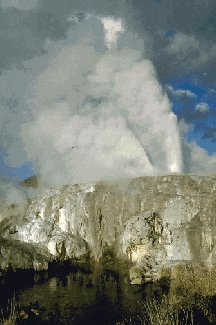![]()
Coasts
Rivers/Lakes
Lowlands/Plains
Geysers/Mud
Glaciers
Mt. Ruapehu
Mt. Cook
White Island
A Maori Legend
![]()
Abbotsford
Aramoana
Ballantynes
Brynderwyns
Cave Creek
Hawkes Bay
H.M.S. Orpheus
Influenza
Mt. Erebus
Mt. Tarawera
Rainbow Warrior
Seacliff Hospital
Tangiwai
Wahine
![]()
Annie Aves
Ata-hoe
Daisy Basham
Jean Batten
Minnie Dean
Mabel Howard
Margaret Mahy
Kath Mansfield
Kate Sheppard
Kiri Te Kanawa
Catherine Tizard
Murray Ball
Charles Goldie
Edmund Hillary
Richard Pearse
Lord Rutherford
Charles Upham
![]()
NZ FAQ--Funny
NZ Links
Credits
Boiling mud, geysers, steam vents and bubbling hot springs are found predominantly from Lake Taupo through to White Island. This thermal activity provides a great attraction to tourists who flock to the Rotorua area to view the action. Geysers are caused when water seeps down from rivers and lakes onto concentrations of hot rock, heats up rapidly and then explodes out of the nearest available vent. Water is heated beyond boiling point and then flashes into steam, violently forcing out any water held above the flash point. Because of the part played by pressure geysers are at their most active when barometric pressures are low.
Around geysers you will usually find beautifully shaped silica formations that are caused by minerals in the expelled water and steam. These come in a rainbow of colours tinted by various algae. Some geysers erupt quite naturally many times each day, however those that don't can be gently encouraged to perform for the tourists by the addition of soap flakes. For many years it was been thought that the minerals in this water had beneficial health effects and in the late 1800's people came from all over the world to bathe in spas that claimed various healing properties. The Polynesian Pools are still popular with people who have arthritic complaints, spastic ailments, skin conditions and nervous diseases. Other tourists are attracted by the simple pleasures of bathing in hot springs. In the thermal areas of New Zealand varieties of tropical fern can be found which will not grow anywhere else around the country. The constantly warm ground provides habitats similar to those found in much hotter parts of the world. Throughout the parks of Rotorua you will find sinkholes of boiling mud or water. These are carefully fenced to protect the public and there have been no incidences of people falling into pits in recent years. Anyone that did -- either by choice or accident -- would have little charge of survival. Studies have found that the Rotorua hot springs are fed by water heated under pressure to more than 200 degrees celsius. Another result of all this thermal activity is an extra hazard to be found on the Rotorua golf course! Plus it has been necessary for some churchyards to raise graves above ground. In past times many residents put the thermal activity to good use heating their homes and swimming pools, cooking with tapped steam, and sinking bores. In 1996 fears for the geyser valley led to the closure of many bores after pressure started to reduce substantially and subsidence problems occurred. Along with all this thermal activity comes the distinctive odour of hydrogen sulphide which pervades the city of Rotorua and is very similar to rotten eggs. Visitors initially find this smell very off-putting but after a short time awareness of the pong disappears.
|




